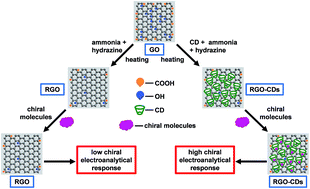Cyclodextrin functionalized reduced graphene oxide for electrochemical chiral differentiation of tartaric acid†
Abstract
Tartaric acid (2,3-dihydroxybutanedioic acid, TA) is one of the major organic acids with a wide range of applications in industry and life. To detect various types of TA, we examined the use of three kinds of cyclodextrin (CD) based reduced graphene oxide (RGO) materials (RGO-CDs) as electrode materials for electrochemical enantiorecognition. Graphene oxide (GO) was prepared via a modified Hummers' method and reduced with hydrazine hydrate to afford RGO, where CDs (α-, β-, and γ-CD) were added in the reduction process affording the desired RGO-CD composites followed by characterization with thermogravimetric analysis (TGA), Raman spectroscopy (Raman), and X-ray diffraction analysis (XRD). RGO-CD modified electrochemical sensors were fabricated thereafter by coating the prepared RGO-CDs on a glassy carbon electrode (GCE) with methylene blue (MB) as the indicator and applied for the enantiorecognition of model racemic analytes via cyclic voltammetry (CV) analyses. The good linear relationship between the current difference and analyte concentration as well as the single isomer percentage indicates that the as-prepared sensors have great potential for chiral resolution.



 Please wait while we load your content...
Please wait while we load your content...